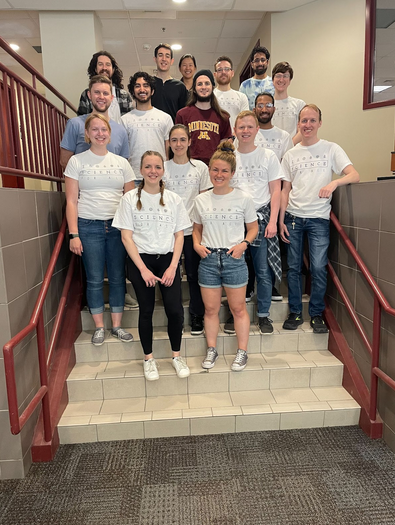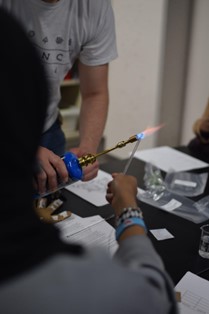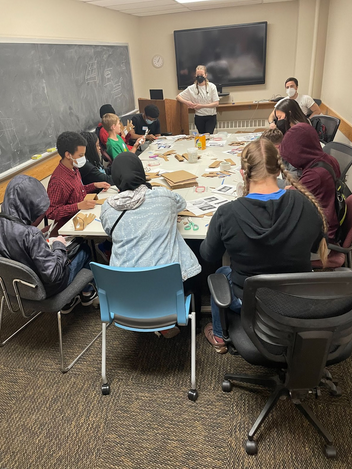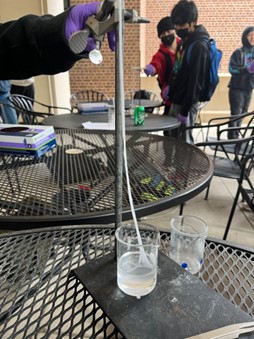After being canceled for two years due to the COVID pandemic, Science for All was able to reinstate the end-of-year field trips for the classrooms we partnered with over the school year. Two of the three schools we worked with this year were able to attend field trips to the University of Minnesota campus. Over two days, we had Heritage STEM Academy (30 ninth grade students) and Murray Middle School (20 seventh and eighth grade students) on campus for a full day of experiments. There were three experiments, lunch with faculty, and liquid nitrogen ice cream.

Chemical Engineering and Materials Science Experiment:
For our materials science experiment we had the students examine the three different glasses before and during time with the glasses in a flame. We looked at how each glass behaved and how the flame color depends on the glass composition. The students were very interested in the flame colors and the sagging of the glass. We followed the heating of the glass with quenching in cold water to observe thermal shock. They also enjoyed quenching the glass. After heating and quenching each glass rod, the leads made sure to let the students relate their observations to the actual CTE and thermal conductivity values of that glass using a worksheet developed from the one in the kit. This taught them how large the impact of materials properties is on the behavior of a material. During the “Thermal Shock!” experiments, we occasionally took a small group of students to our lab (PI: David Poerschke) to show them what a typical day looks like for researchers in the structural ceramics field during a 10 minute tour. We briefly introduced them to equipment such as box and tube furnaces, spark plasma sintering, and arc melting setups. The “Hot or not?” experiment was combined with this lab tour, where one of the leads heated one side of the refractory brick with a torch. The students were allowed to point a laser pyrometer at the spot that was being heated and a thermometer was inserted into the other side of the brick. Students took joy in using the pyrometer and were surprised to see that the other side of the brick remained cool. Read more about how the Ceramic and Glass Industry Foundation funded this experiment in their article featuring our volunteers Koen and Brady!

Biomedical Engineering Experiment:
For the biomedical engineering experiment, the students fabricated prosthetic hands from common household items. First, a presentation was given which explained what biomedical engineering is as a field as well as some important information regarding the manufacturing and use of prosthetics (including most commonly made prosthetics, materials, current UMN prosthetics research, and future outlook). Next, the students were given cardboard, string, cut straws, and scissors to make their own prosthetics. The hand itself is made of cardboard, while the strings can be connected to fingers on a real hand to move the cardboard fingers. We emphasized that, while these prosthetics are quite simple, often engineers will prototype devices using simple materials first, and much trial-and-error is needed before reaching a final product.

Chemistry Experiment:
For our chemistry experiment, we used a time-tested experiment from the realm of polymer science: the nylon rope trick! After all the reagents and apparatus were assembled at the tables, we gave a brief presentation to the students on the field of chemistry, the sub-field of polymer chemistry, and the myriad applications and everyday uses of polymers. As part of this, we overviewed the two main types of polymerizations, chain growth and step growth. To give the students a more tangible feel for step growth polymerization, we divided the group in two and gave each sub-group either blue circles or red squares to be held in both hands. We then instructed the students to link up with the rule that only blue circles could link with red squares, just as in an AA-BB step growth polymerization. After a few minutes, we had linked all the students into one big chain. Then, two volunteers performed the experiment. A solution of adipoyl chloride in cyclohexane was carefully poured on top of a layer of hexamethylenediamine in water in a small beaker, and then the film at the interface was pulled upward to form a continuous polymer strand - nylon-6,6! The strand was attached to a clamp on a ring stand that could be rotated to continue the polymerization and spool the nylon. The students were given gloves and lined up to spool the nylon and touch the squishy product. We concluded by drawing the direct parallel between the symbol-linking activity and the behavior of the two monomers at the meniscus between the two liquid layers during the polymerization.

During lunch each day, we had three faculty members attend to talk with the students about science and research. The goal of this is to encourage students to begin thinking about their future and having conversations with faculty members about the vast array of pathways available. At the end of the day, we made liquid nitrogen ice cream with the students. Grad students demonstrated the process and were the only people handling the liquid nitrogen with proper PPE (cryo gloves and eye protection). The liquid nitrogen was slowly poured into the ice cream mixture and stirred until the ice cream had frozen. Then the liquid nitrogen was allowed to completely boil off before serving to the students. We discussed safety of liquid nitrogen and also uses of liquid nitrogen in research labs. To demonstrate the flash-freezing capabilities of liquid nitrogen, we froze marshmallows and allowed them to shatter by throwing onto the sidewalk. Overall the field trip days were a great success and the students and visiting teachers had fun learning about the various experiments and visiting the UMN campus.